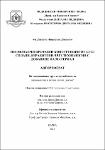I hereby declare that I will use the electronic library contents in compliance with COPYRIGHT AND RELATED RIGHTS ACT, Article 24, paragraph 1, item 9, only for scientific, cultural and educational purposes, without commercial gain, without commercial interest and non-profit.No Yes

Fixed Partial Dentures of Co-Cr Alloys Using Additive Manufacturing //// Неснемаеми протезни конструкции от Co-Cr сплави, изработени чрез технологии с добавяне на материал

Date
2017Author
Dzhendov, Dzhendo
Джендов, Джендо
djendo.djendov@mu-varna.bg
Metadata
Show full item recordAbstract
Depending on the clinical situation and patient's condition, the restoration of missing teeth is carried out in various ways. Treatment with Fixed Partial Dentures (FPD) ensures very good aesthetics, physiological transmitting of the chewing load, even distribution of the masticatory loads and greater durability compared with the removable partial dentures. Conventional technology for production of FPD by casting with hand-built wax pattern is characterized with low accuracy, long-lasting manufacturing process and a high price. During the past 20 years innovative technologies enter very rapidly in the dental laboratories. The implementation of CAD-CAM systems lead to the elimination of many manual operations, increase the accuracy of the dental construction and decrease the time for their production. In the recent years, there is greater emphasis on the development of technologies for production by adding of material, so called Additive Technologies (AT) or Additive Manufacturing (AM). They give opportunity to produce complex personalized details of a wide range of materials - polymers, composites, ceramics, metals and alloys. They allow manufacturing of dense parts and parts with a predetermined porosity and surface roughness as well. The processes used are fast, reliable and easy for managing and control. The new equipment and the new technologies rapidly evolve and enter almost immediately after their development in dental laboratories and dental surgeries. The experience to work with them and the data associated with their application are insufficient. Therefore, the aim of the present work is to investigate the geometric accuracy and mechanical properties of fixed partial dentures of Co-Cr alloys produced by additive technologies, and to propose clinical and laboratory protocols for their application in dentistry. В дисертационния труд е направен сравнителен анализ на свойствата на неснемаеми дентални конструкции, произведени по: 1) класическа технология – леене по восъчни модели; 2) леене по модели, изработени чрез 3D печат и 3) избирателно лазерно стопяване. Разработена е методика за изследване точност при ажустиране на неснемаеми протезни конструкции с CAD софтуер. Установено е, че мостовите конструкции, отлети с 3D принтирани модели, са с най-висока точност, но са с по-голяма грапавост в сравнение с конструкциите, изработени по класическата технология (Ra=3.39 µm и Ra=1.11-1.31 µm съответно). Доказано е, че якостта на адхезия на керамично покритие към сплав Co212-f, изработена чрез ИЛС, е с 23% по-голяма от тази на керамика към отлята сплав Biosil F (83,1 МРа и 67,5 МРа съответно). Дефинирани са термините “частично дигитализиран план на лечение“ и „изцяло дигитализиран план на лечение“. Потвърдено е, че грапавостта на мостовите конструкции, изработени чрез ИЛС, е най-висока (Ra=4.24 µm) в сравнение с грапавостта на неснемаеми протези, изработени чрез леене с ръчно изработени или 3D принтирани модели. Потвърдено е, че твърдостта и границата на провлачване на образци от Co-Cr сплави, изработени чрез ИЛС (382 HV0,1 и 39 HRC, R0.2= 720 MPa), са по-високи от тези на образци, изработени чрез центробежно леене (335 HV0,1 и 33 HRC; R0.2= 410 MPa). Разработени са клинични протоколи за приложение на технологиите с добавяне на материал за производство на неснемаеми протезни конструкции.
